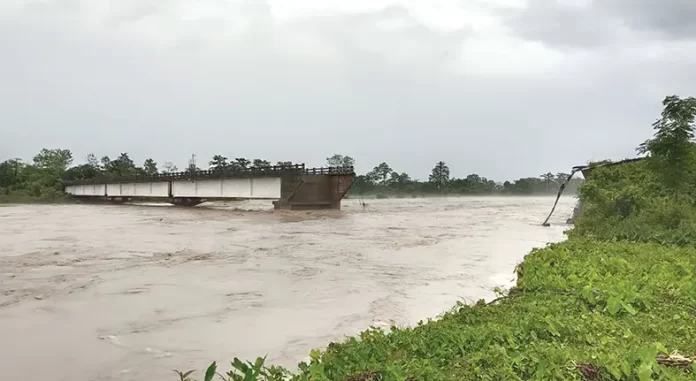[ Pisi Zauing ]
MAKANTONG, 1 Jun: Buri-Dihing, the tributary of the Noa Dehing river, washed away 50% of the Makantong bridge on 31 May in a flash flood. The bridge, along the Trans-Arunachal Highway, connected Miao and Bordumsa administrative subdivisions of Changlang district.
The people of Miao and Bordumsa administrative subdivisions are farmers and they depend solely on agriculture and horticulture produces for their livelihood. But the washing away of the Makantong bridge will now become a nightmare for the farming community as they will have to rely on alternative routes to transport their produces to neighbouring Tinsukia district in Assam for sale. Not only will the cost of transportation via alternative routes be high, but uncertainty would continuously keep them in its grip.
The damage to the bridge would significantly impact the businesses of the farmers. It would disrupt transportation routes, making it difficult or impossible to deliver agricultural and horticultural inputs and products to the markets on time. This would lead to increased costs, market instability, and reduced income for the farmers of the two administrative subdivisions.
Disruptions in transportation due to damage to the Makantong bridge would undoubtedly lead to price fluctuations, making it difficult for the farmers to sell their produces in a timely manner.
The farmers of the two subdivisions would experience lower yields due to damage to crops and livestock, and they may also lose income due to disruptions in their ability to sell their produce.
The outcome of the flash flood can force the farmers to adapt their farming practices, leading to long-term changes in cropping patterns and land use, which can affect productivity and land values.
Throughout Changlang district, flash floods have proved devastating, resulting in crop damage and soil erosion. The flash floods present immense challenges to both farmers and landowners. Beyond the economic losses, the long-term environmental consequences that affect sustainability of farming practices must also be considered.
In several places of the district, especially in Dharmapur block in Namphai circle, farmlands have been inundated by flood water, causing direct damage to planted crops by submerging them.
The flooding would make fields inaccessible for planting, harvesting, and other activities. Saturated soil conditions and standing water challenge effective operation of machinery and equipment.
In many places water from flash floods has damaged agricultural infrastructures such as drainage networks, buildings, storage facilities, and irrigation systems. Replacing or repairing these structures are costly and time-consuming for the farmers. The floods have also posed a threat to livestock by submerging grazing areas, barns, and feed storage facilities.
It is expected of the Changlang district administration to engage the departments concerned to assess the losses incurred by the farming community and others at the earliest and initiate steps to compensate for the losses.


